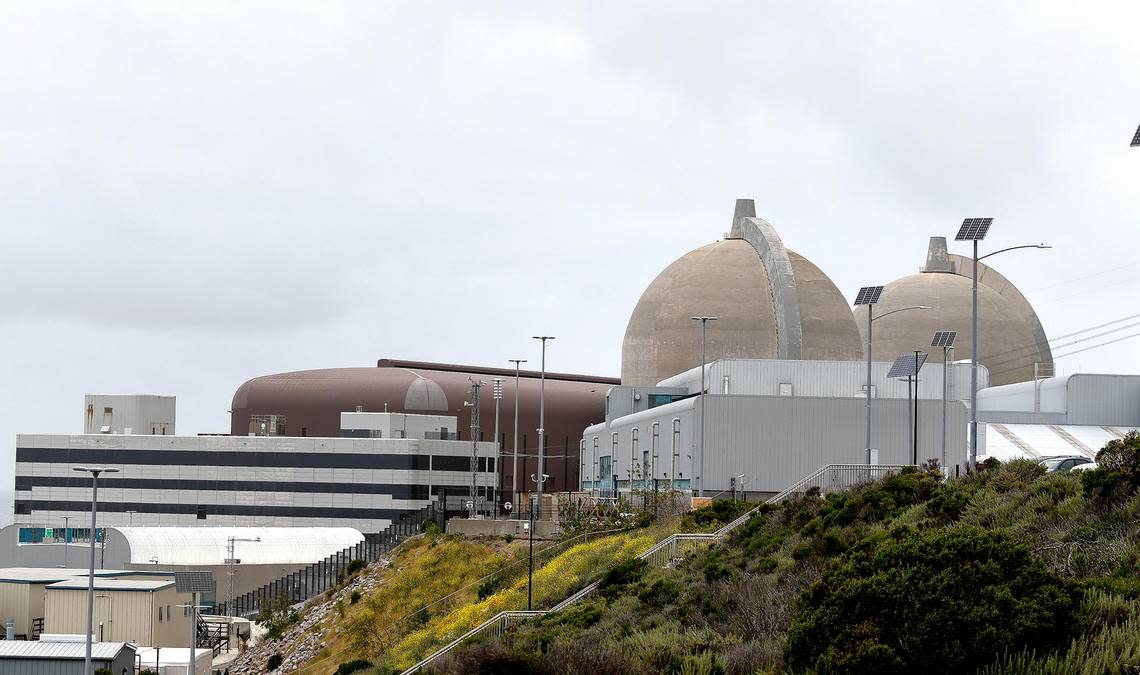California lawmakers fold in budget spat, approve Gavin Newsom’s $400M loan to Diablo Canyon

- Oops!Something went wrong.Please try again later.
California lawmakers agreed to loan Pacific Gas & Electric Co. an additional $400 million to extend the life of Diablo Canyon nuclear power plant, ceding to Gov. Gavin Newsom’s push for the loan after initially refusing to pay in a public budget spat.
Newsom, who brokered a 2022 deal to extend the nuclear plant’s operations with state loans to be covered by the federal government, has argued that Diablo Canyon is critical to maintaining grid stability as the state transitions to clean energy.
Legislative leaders questioned the necessity and cost-effectiveness of keeping the plant open, initially rejecting the loan out of concern that taxpayers and PG&E ratepayers could end up footing the bill for substantial parts of $1.4 billion in loans.
But the budget deal released over the weekend after weeks of negotiations between the governor and lawmakers includes the $400 million allotment, along with a requirement for the Department of Water Resources to report on how the money will be spent and unpaid balances.
“The final budget deal with the Governor represents a total capitulation to PG&E and its shareholders,” Utility Reform Network attorney Matthew Freedman wrote. “This $400 million will never be paid back to the general fund, forcing taxpayers to absorb the costs.”
The governor’s office deferred questions to the DWR, which oversees the PG&E loans. Several lawmakers did not respond to requests for comment.
“Keeping Diablo Canyon Nuclear Power Plant online is prudent and cost effective,” said DWR spokesperson Ryan Endean in a written statement, citing the need for grid reliability under extreme heat waves.
It’s important that PG&E receive money from the state needed to extend its operating license, Endean said, or else the plant will be ineligible for federal funds and “none of the $1 billion the state has already loaned to PG&E could be repaid.”
Diablo Canyon, California’s last nuclear power plant, contributes roughly 9% of the state’s energy on a given day. It was initially set to close in 2025 in an agreement with labor unions after years of pressure from environmental groups and community organizations.
Two years ago, during a budget surplus and searing summer heat that threatened blackouts, Newsom passed SB 846 to extend its life to 2030. He said it would preserve reliability of the grid with zero-carbon electricity as more renewables come online.
The governor’s 2022 extension deal authorized a $1.4 billion loan from the state’s general fund to support the plant’s operations, with the expectation that PG&E would repay it using a federal grant — but the U.S. Energy Department awarded the utility only $1.1 billion.
According to communications between PG&E staff to DWR, the federal award guarantees only $741 million, with the potential for $1.1 billion. Finance department and legislative analyst staff also agreed that timing and amount for loan repayment remains uncertain.
At a legislative hearing last month, Sen. Josh Becker, D-Menlo Park said “We are frustrated, I’m frustrated. When you hear the numbers on PG&E profits at a time when we’re asked to give additional loans... It doesn’t add up.”
PG&E reported last year that the company saw its profits surge by almost 25%, almost immediately after issuing substantial rate hikes.
Friction between governor and lawmakers during budget negotiations unfolded as environmental and anti-nuclear advocates warned of a growing price tag to keep the plant open, roughly doubling from $6 billion to nearly $12 billion.
An anti-nuclear environmental group also sued the federal Energy Department, arguing the agency failed to consider environmental impacts from extending the plant’s life such as disaster risk from potential earthquakes.
David Weissman, executive director of the Alliance for Nuclear Responsibility, said the deal was struck based on promises that taxpayers and ratepayers would not foot the bill and large amounts of battery storage have drastically improved grid reliability.
“We’re disappointed in this decision and I don’t know why the legislature changed their mind over 24 hours,” he said. “The cost of this extension continues to balloon and skyrocket... We think this money is better spent continuing to develop technologies in the renewable sector.”
PG&E, the plant’s operator, said Diablo Canyon continues to be California’s “single largest source of clean energy.”
“The notion that Diablo Canyon Power Plant provides little public benefit could not be further from the truth,” said PG&E spokesperson Suzanne Hosn in a written statement, saying the net benefit of the plant’s operation amounts to $500 million per year.
“Diablo Canyon remains the only cost-effective resource available to meet the state’s energy demands, the Governor and state Legislature have directed us to continue operating the plant until its output can be replaced by renewable energy resources.”
The San Luis Obispo Tribune’s Stephanie Zappelli contributed reporting.


